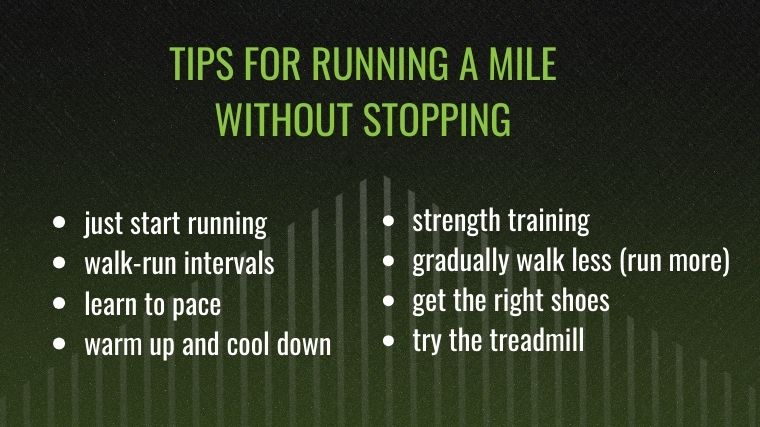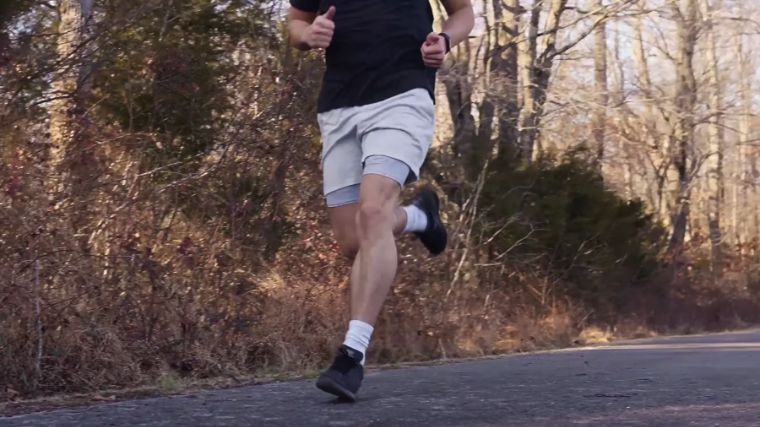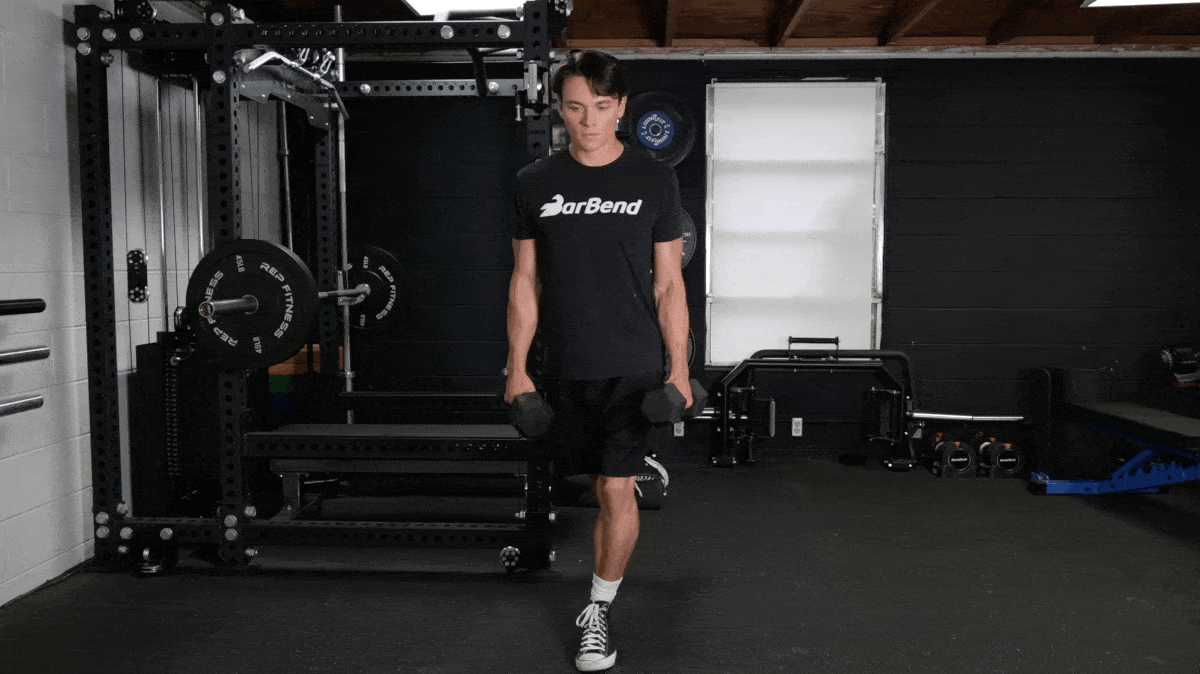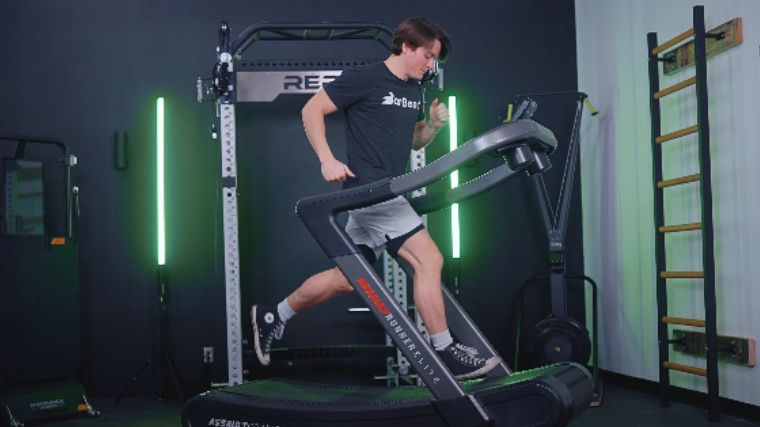Contrary to what your high school gym teacher might have thought, it’s certainly not easy to simply lace up your running shoes, toe the starting line, and run an entire mile. That’s over 1,600 meters or about 2,000 steps for many people. That’s a whole lot of ground to recover without slowing down. So how do you run a mile without stopping?
To help you along your path to running a continuous mile, I sat down for a chat with elite running coach Lee Whitaker. Along with being certified by U.S. Track & Field, Whitaker is one of the premier high school distance running coaches in the country. With Whitaker’s advice, you’ll be able to start your running journey off on the right foot.
Tips for Running a Mile Without Stopping
It’s not just about getting up and going — but yes, you also do need to start somewhere. Here’s how Whitaker advises you to go about it.

Just Start Running
At first, don’t worry about speed. Sure, it’s cool to have a “fast” time, but remember that fast is relative. The first step is to actually finish that first mile, no matter how slow it might be. Whitaker encourages you to simply start running and see how long you can maintain an unhurried run pace without stopping.
[Read More: The Best Treadmills for Running]
“If you come to me and want to run a mile, I’m going to tell you to just start running, and I’m going to ask you to try to do it at an aerobic threshold pace,” explains Whitaker. “This means you need to be able to run at a conversational pace, where you could talk with a friend without gasping for breath or having to alter your speech. Your eventual goal should be to try to sustain that sort of running pace for 20 minutes.”
Perform Walk-Run Intervals
If you haven’t yet been able to run a continuous mile, that’s OK. Use walking to your advantage. You can piece together a series of jogging, then walking, then jogging, then walking — intervals — to total a mile or more. Gradually, you’ll build your ability to run longer without taking those walking breaks.
[Read More: The Best Treadmills for Walking]
“It can be helpful to run for five minutes and then walk for five minutes, and repeat that process for as long as you can,” explains Whitaker. “Then you can start to change those ratios. You can do an eight-minute run and a five-minute walk, or a five-minute run and a three-minute walk. You can keep interspersing your runs with walks and then shorten those gaps over time until you can run one continuous mile without stopping.”
If five minutes is too much to start with, go even lower. A 30-second jog will eventually become a one-minute jog, and on and on until you can run that mile.
Learn to Pace
Yes, pacing is an advanced skill that experienced runners will need to develop. If you say to a seasoned runner, “run at your mile pace” or “jog at your 10K pace,” they may very well know exactly how fast to go. Newbies, however, don’t yet have an established running mile time. No worries — you’re going to estimate to help you create some goals.
“It’s not perfect, but you could still test yourself by running 400 meters and getting a sense of what your mile-running potential is,” Whitaker says. “Do some testing around the track and determine what kind of pace it takes to reach [a certain mile time] and run beyond them.”

[Read More: The Best Budget Treadmills on the Market]
If it takes you five minutes to run 400 meters, a full mile (four sets of 400 meters) will likely take around 20 minutes (five multiplied by four). Keep that in mind as you train. Or maybe you can run that 400 meters in four minutes, so you’re aiming for a 16-minute mile to start. Find what feels reasonable and exciting to you and keep those numbers in mind to help pace your runs.
Warm Up and Cool Down
It might be tempting to kick everything but the actual workout to the curb, especially if you’re pressed for time. However, a sufficient warm-up and cool-down can help you prevent injuries and preserve your health. This is why Whitaker always advises his athletes to warm up and cool down in a fashion that doesn’t interfere with their training goals.
[Read More: The Best Folding Treadmills]
“Warming up is really important,” explains Whitaker. “You want your muscles to be warm and pliable, and you want your movement mobility to be adequate for running. I think a proper dynamic warm-up is essential for running regardless of your fitness level. Whether you’re a beginner or advanced, a proper warm-up and cool-down are very important.”
Strength Train
Squats, lunges, and other lower-body strength exercises are often included in the training programs of experienced runners, and they benefit beginner runners, too. By forging a stronger lower body, you’re supporting your legs in their ambition to run that continuous mile.

[Read More: The 5 Best Running Workouts]
“Strength training is good for everybody regardless of whether they’re a beginning runner or an advanced runner,” insists Whitaker. “Strength training for a beginner is more about injury prevention and establishing good form. It’s certainly important, but probably not the prime focus of a beginner.”
Try one or two strength sessions per week to start.
Gradually Walk Less (And Run More)
You don’t want to walk less overall in your life, but as you gain more strength and endurance, you’ll eventually need to run more during your workout. In the early stages, you can walk fast to accelerate your heart rate. However, you’ll eventually need to increase the ratio of the time you spend running versus walking during your sessions.
[Read More: The Best Nordictrack Treadmills — Yes, We Tested Them All]
“You can certainly walk fast and get an aerobic threshold workout in, but as your fitness level improves, you want to have more and more running,” says Whitaker. “There’s nothing wrong with a beginner walking quickly and getting their heart rate up because it’s all helpful; your cardiac system doesn’t know if you’re walking or running. But the fast walking you’re doing today won’t get your heart rate to the same place weeks from now. You’ll need to increase your run time.”
This can be as little as adding 30 more seconds of running per training session. Just make sure you’re trending in the speedy direction.
Get the Right Shoes
Running a mile is primarily about your aerobic conditioning, not the fancy new kicks you’re sporting. Still, wearing the right running gear can help you stay comfortable, which means you may want to take a trip to the shoe store early on in your training.
[Read More: The Best Cross-Training Shoes (Personally Tested)]
“Having the right footwear is certainly important for beginner runners no matter what distance they’re running,” adds Whitaker. “It’s all about comfort and owning a shoe that is suited to your biomechanics.” This way, you can stay on your feet long enough to make the improvements that you need to your running.
Try the Treadmill
Getting outside for your runs grants undeniable benefits, to be sure. But if the weather is getting you down, or you’re simply more comfortable training at home, locking into the best treadmill is a great way to get that practice in. It may also be easier on your joints.

[Read More: The Best Commercial Treadmills]
“A beginner can get a lot of benefit from the treadmill because it’s all about just getting them running at a level they can sustain for some time,” says Whitaker. “[Treadmill running] may even be a little more beneficial than outdoor running early on because it’s not as hard as the sidewalk or the asphalt.”
Training Plan to Run Your First Mile
To help you get where you want to go, Whitaker has assembled a repeatable weekly training plan for people who are already capable of running for at least three minutes without stopping.
If you are presently unable to run at all, or if you can’t run for three consecutive minutes just yet, fear not: Whitaker has provided you with a workout plan that can be repeated until you progress to the point where you have enough stamina to string together longer runs.
Weekly Plan for Someone Who Can’t Run Comfortably
| Day 1 | Fast aerobic walking (30 minutes) |
| Day 2 | Fast aerobic walking (30 minutes) |
| Day 3 | Fast aerobic walking (30 minutes) |
| Day 4 | Fast aerobic walking (30 minutes) |
| Day 5 | Rest |
| Day 6 | Short walk-run interval session |
| Day 7 | Rest |
Weekly Plan for Someone Who Can Run Comfortably
| Day 1 | Long walk-run interval session (20 minutes) |
| Day 2 | Short walk-run interval session with longer running workout intervals (10 minutes) |
| Day 3 | Fast aerobic walking (30 minutes); Strength training (lower body and core) |
| Day 4 | Rest |
| Day 5 | Long walk-run interval session (20 minutes) |
| Day 6 | Shorter walk-run interval session with longer running intervals (12 minutes) |
| Day 7 | One-mile run (attempt to run a mile at a controlled pace, and see how well you do) |
Frequently Asked Questions
If you still have questions about how to get yourself to complete a one-mile run as quickly as possible, we’ve got the answers to your questions below!
How do I train myself to run a mile?
The most reliable method of training yourself to run one mile is to practice fast walking and running. This method can quickly build up your endurance to complete a one-mile run. Interspersing runs with walking keeps you in motion while you recover and prepare for the next running bout. Over time, you’ll be able to run longer with shorter walks in between. Eventually, you’ll be able to get to the whole mile while running.
How do you pace a one-mile run?
A one-mile run is typically paced by establishing what your body can comfortably sustain for a quarter mile (400 meters). From there, you can project a one-mile target time and then attempt to maintain that pace over three additional quarter miles of running.
How long does it take to build up to run a mile?
Whitaker says that individual circumstances and adaptations to training will vary. However, if you aren’t dealing with any injuries, you may be able to run a continuous mile within three weeks. This projection assumes that you can already run for three minutes without stopping.
Editor’s Note: The content on BarBend is meant to be informative in nature, but it should not be taken as medical advice. When starting a new training regimen and/or diet, it is always a good idea to consult with a trusted medical professional. We are not a medical resource. The opinions and articles on this site are not intended for use as diagnosis, prevention, and/or treatment of health problems. They are not substitutes for consulting a qualified medical professional.